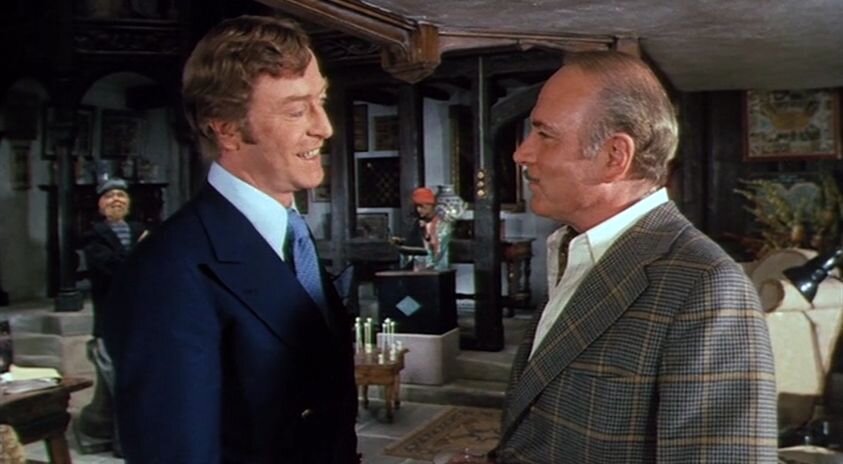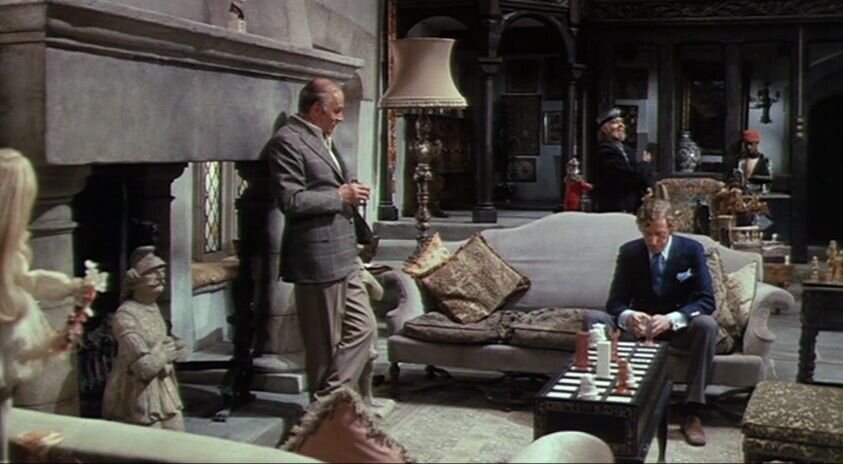Sleuth – Before & After
This piece contains general spoilers for the first half of both the 1972 and 2007 versions of Sleuth. At the time of publishing, there is no easy way to watch the 1972 film, short of buying a used DVD off eBay. But it is a fantastic film, and I very much encourage you to seek out a copy of it for yourself, so I have left out any discussion of the film's second half so as not to spoil the game.
(NOTE: This piece has been adapted into a video essay. Watch here.)
You can tell a lot about a person by how they keep their home. Whether they have books, or a television. What pictures they put on display. These things may not paint a complete picture of a person, but they can tell you what a person deems important. In film, production designers can use this principle to express the inner lives of the characters. Think of the McCallister family's suburban palace-turned-playground in Home Alone, the impossibly chic West 81st Street murder den of Patrick Bateman in American Psycho, or the eclectic house of games and sharp objects of the Thrombeys in Knives Out. These spaces are nearly as iconic as the characters who inhabit them, because space and character define each other.
I live alone and have barely left my home in 11 months of lockdown. I've given up any attempt at looking presentable, so I've become more acutely aware of how my home, and the stuff in it, is now the primary outward expression of who I am. It makes me feel like a character, my inner life reflected back at me from the bookshelves and the art on the walls. The home is me, and I am it. And my quarantine-isolation-addled brain can't help but wonder: if I made a fundamental change to my character, how would my home change?
The two film versions of Sleuth, from the stage play by Anthony Shaffer, are a case study for this question. Both films are broadly the same on the surface; they both have the same plot, only two characters (and share an actor), and are set in a single location, a big country house. But despite their similarities, the films, their characters, and their locations feel nothing alike.
The house of the 1972 film sits in the English countryside, surrounded by enough land that it is unlikely for any passers-by to hear gunshots coming from inside the home. We first meet homeowner Andrew Wyke (Laurence Olivier) in his garden study, dictating/performing the denouement of his latest bestseller into a tape recorder. Wyke's study is located at the center of a high-wall hedge maze of his own design. Poor Milo Tindle (Michael Caine) is confounded by the maze until Wyke reveals that the entrance to the study is through a hidden doorway in the hedge. Wyke loves to play games, and there's always a trick.
Pleasantries dispensed with, the two men move to the house. It's grand, old English castle chic. Production designer Ken Adam (who has an astonishing list of credits) perfectly captures Wyke, with the cavernous living room large enough to contain Wyke's ego, filled with trinkets, baubles, and parlor distractions. It’s an impressive collection, if a bit tacky, but everything in the room is, in whole or in part, a game. Lording over it all is Jolly Jack Tar, a remote-controlled sailor automaton who laughs on command. Wyke enjoys the relationship he has with the automaton: “I make the jokes, he laughs at them.” Wyke's house, Wyke's rules.
Then Wyke gets to the point: his wife is sleeping with another man, and that man is Tindle. But rather than punish Tindle, Wyke wants to help Tindle not only take his wife, but keep her as well. As a world-famous novelist, Andrew Wyke is absurdly rich. As the owner of two hairdressing salons (one of which is actually breaking even), Milo Tindle is not. Wyke believes if Tindle cannot keep his wife, Marguerite, living in the lavish style to which she has become accustomed, she will leave Tindle and come crawling back to Wyke and his money. Wyke does not want this; he wants Marguerite to go and stay gone. And so Wyke has invited Tindle to his home to enact a plan that benefits himself, Tindle, and Marguerite.
Like the garden maze, the meeting of these two men is a game, and like the garden maze, the board is designed by Wyke.
Though most of the film's action plays out in and around the gaudy living room, Wyke takes Tindle around the house in a whirlwind, first to put him at ease by making merry and playing with an old chest full of theatrical costumes, then to frustrate him with a climb up the side of the house in a clown costume to set him off balance so he doesn't see where the game is headed.
In Wyke's indoor study, the author tests the hairdresser by challenging him to find a locked safe hidden somewhere in the room. After a bit of searching, Tindle discovers it by picking up a dart off the desk and landing a bullseye in the dartboard on the wall. The dartboard swings open, revealing the safe. When Wyke asks Tindle how he knew, Tindle points to the dartboard and replies, "That is the only game in this room."
Tindle plays Wyke's game, a scheme where Tindle "robs" the house and "steals" a valuable necklace, so that he can fence it and use the money to keep Marguerite living in luxury, while Wyke claims the insurance money. Tindle plays the game happily, humiliating himself in the process, all the way up to the point where Wyke draws a gun and reveals the true nature of the game: he has set up Tindle as a burglar so that Wyke is within his rights to shoot him dead.
Wyke is so obsessed with games, he not only filled his house with them, and the accoutrements to play them, but he turned the house itself into a game board so that he could play this sick game with Tindle, with full control over the outcome. He even performs the narration of the denouement to Tindle in a fashion similar to how he dictated his book at the film's start. And while this element of near-pathological control is a major part of the Andrew Wyke of the 1972 film, it is the defining characteristic of the Wyke of the 2007 film.
The remake of Sleuth is identical in premise and structure to its predecessor, but it is in many ways a more theatrical adaptation. Michael Caine has shifted into the role of Andrew Wyke, and he plays the character with more detachment and cruelty than Olivier did. Milo Tindle, now an actor, is played by Jude Law, who amps up the charm and charisma as only Jude Law can. They are bigger versions of the characters, who go to greater emotional extremes. But the greatest change is in the film's third character: the house.
Remake-Wyke's house is still a mansion in the English countryside, surrounded by an unreasonable amount of land, but it is no longer full of eccentric games. There are no dartboards or costumes or laughing automatons. The house itself is no longer a game board. It is now a stage, and Andrew Wyke is the director.
Production designer Tim Harvey created a house that looks like it was styled by a theatrical set designer, or a modern artist, rather than an interior decorator. This home, if you could call it that, is a cold, postmodernist nightmare. The walls and floor are covered in concrete and stone, the chairs are as visually striking as they are uncomfortable, the directional lighting is reminiscent of the sort that would be hanging from a theatre's lighting grid, and the doors have all been replaced with moveable walls, so they open like pieces of the set being moved by unseen stagehands. Where the house of the original film is a bit idiosyncratic, the house of the remake is downright hostile.
There are also two technological additions to the house that were not possible in 1972. First, a sophisticated CCTV security system, with cameras all around the house, inside and out. A voyeuristic, audience-eye view of the proceedings. A stage, after all, is only one half of a theatre, and the many glimpses of unattended security monitors we see make it feel like perhaps the audience is not us, but the house itself. This security system, and everything else in the house, respond to Wyke's commands on the second bit of fancy modern tech, a magic remote control.
With a simple press of a button, the house seems to telepathically understand Wyke and do his bidding, it is that advanced. The remote opens doors, turns on lights, activates a projector, controls the security systems, and generally whatever else the script dictates. The new Andrew Wyke is obsessively manipulative, and he uses all this technology to not only play a game with Tindle, but to revel in every moment of humiliation he inflicts upon the young man. By directing Tindle through the CCTV monitors Wyke is effectively making a movie of Tindle’s eventual demise.
This technology-focused update to the house is indicative of another aspect of remake-Wyke's cruelty: the way he flaunts his money in front of Tindle. Class division is at the heart of both films; Tindle needs money, Wyke has it. But the 2007 Sleuth makes the class divide between Wyke and Tindle even wider. This is made clear in the film's opening moments, before we even enter the house, when Tindle pulls up the driveway in his crappy hatchback and parks next to Wyke's brand-new Mercedes S-Class. Tindle is now an actor who works infrequently, which means he's even less well-off than the salon-owning Tindle in the first film (who could at least afford a convertible).
The exterior of the house looks similar to the house of the 1972 version, but the inside is painfully modern, which means it was gutted and expensively renovated, and it even has a room that serves as Wyke’s museum to himself. The lofted bedroom is accessible by the atrium elevator. And every time Wyke uses his magic remote to make the house do something, he's demonstrating a new piece of technology that had to be designed, manufactured, installed, calibrated, and maintained. The house drips with wealth, and it's covered with security cameras to make sure it stays that way. Not only is remake-Tindle poorer, remake-Wyke is wealthier.
The films' respective houses, while both symbols of upper-class opulence, are owned by very different men from different times. In the 1972 film, the house is old, a bit stuffy, but full of childish things that excite a lover of games with a flair for the dramatic. If the Andrew Wyke of this house didn't originally come from money, he certainly acts like he does. In the 2007 version, by contrast, the house is hard and uninviting, and it bends to the will of a voyeur who demands real-time control. It is a house befitting a more paranoid, more openly-hostile 21st century upper class, and has been designed by Wyke to suit only himself.
Rather than simply doing Sleuth again, the remake makes fundamental changes to the character of Andrew Wyke that force changes to the house where the story is set. Laurence Olivier's Andrew Wyke could never live in the house owned by Michael Caine's, and vice versa. This is good production design, because it comes from character. The homes of these men not only reflect their inner lives, they are extensions of the characters themselves.
Before & After is a series of essays where I examine aspects of films and their remakes.





















